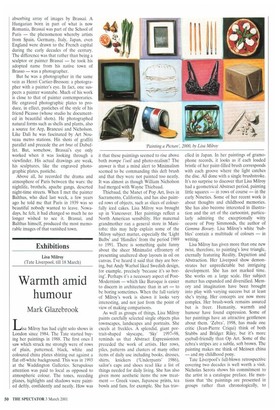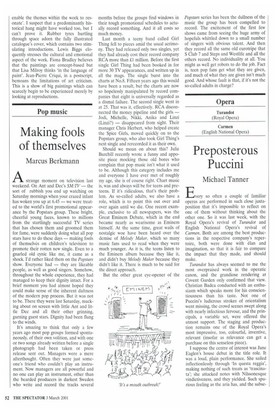Exhibitions
Lisa Milroy (Tate Liverpool, till 18 March)
Warmth amid humour
Mark Glazebrook
Lisa Milroy has had eight solo shows in London since 1984. The Tate started buying her paintings in 1988. The first ones I saw which struck me strongly were of rows of plain, patterned, black, white and coloured china plates shining out against a flat off-white background. This was in 1993 at the Waddington Galleries. Scrupulous attention was paid to local as opposed to atmospheric colour. The tones, receding planes, highlights and shadows were painted deftly, confidently and neatly. How was
it that these paintings seemed to rise above both trompe l'oeil and photo-realism? The answer is that a mind alert to Minimalism seemed to be commanding this deft brush and that they were not painted too neatly. It was almost as though William Nicholson had merged with Wayne Thiebaud.
Thiebaud, the Manet of Pop Art, lives in Sacramento, California, and has also painted rows of objects, such as slices of colourfully iced cakes. Lisa Milroy was brought up in Vancouver. Her paintings reflect a North American sensibility. Her maternal grandmother ran a general store in Manitoba: this may help explain some of the Milroy subject matter, especially the 'Light Bulbs' and 'Handles' from the period 1989 to 1991. There is something quite funny about the sheer Minimalist effrontery of presenting unaltered shop layouts in oil on canvas. I've heard it said that they are boring, but Andy Warhol liked Swedish design, for example, precisely 'because it's so boring'. Perhaps it's a necessary aspect of PostModernism — which like Baroque is easier to discern in architecture than in art — to be boring sometimes. When the full variety of Milroy's work is shown it looks very interesting, and not just from the point of view of making comparisons.
As well as groups of things, Lisa Milroy paints carefully selected single objects plus townscapes, landscapes and portraits. She excels at freckles. A splendid, giant portrait-shaped skyscape, 'Sky' 1997-98, reminds us that Abstract Expressionism preceded the work of artists. Her rows, piles, patterns and clusters of many other items of daily use including books, dresses, shirts, knickers (`Underpants' 1986), sailor's caps and shoes read like a list of things needed for daily living. She has also given more aesthetic items the row treatment — Greek vases, Japanese prints, tea bowls and fans, for example. She has tray
elled in Japan. In her paintings of gramophone records, it looks as if each loaded bristle of her paint-filled brush corresponds with each groove where the light catches the disc. All done with a single brushstroke. It's no surprise to discover that Lisa Milroy had a geometrical Abstract period, painting little squares — in rows of course — in the early Nineties. Some of her recent work is about thoughts and childhood memories. She has also become interested in illustration and the art of the cartoonist, particularly admiring the exceptionally witty oeuvre of Posy Simmonds, the author of Gemma Bovary. Lisa Milroy's white 'bubbles' contain a multitude of colours — in writing.
Lisa Milroy has given more than one new twist, therefore, to painting's love triangle, eternally featuring Reality, Depiction and Abstraction. Her Liverpool show demonstrates her unpredictable but intriguing development. She has not marked time. She works on a large scale. Her subject matter has expanded and diversified. Memory and imagination have been brought into play with varying success but at least she's trying. Her concepts are now more complex. Her brush-work remains assured but is freer. Humanity, warmth and humour have found expression. Some of her paintings have an attractive gentleness about them. 'Zebra', 1998, has made one critic (Jean-Pierre Criqui) think of both Stubbs and Bridget Riley, but it's more eyeball-friendly than Op Art. Some of the zebra's stripes are a subtle, soft brown. The painting makes me think of Meissen china — and my childhood pony.
Tate Liverpool's full-blown retrospective covering two decades is well worth a visit. Nicholas Serota shows his commitment to the artist in a catalogue preface. He mentions that 'the paintings are presented in groups rather than chronologically, to
enable the themes within the work to resonate'. I suspect that a predominantly historical hang might have worked too, but I Can't prove it. Rubber tyres hurtling through space adorn the fully illustrated catalogue's cover, which contains two stimulating introductions. Lewis Biggs eloquently stresses the cultural and emotional aspect of the work. Fiona Bradley believes that the paintings are concept-based but that Lisa Milroy thinks 'in the language of paint'. Jean-Pierre Criqui, in a postscript, bemoans the limitations of art criticism. This is a show of big paintings which can scarcely begin to be experienced merely by looking at reproductions.













































































 Previous page
Previous page